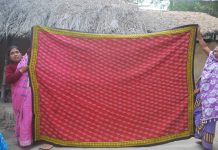Weaving for the craftswomen was not an easy job. The best palm tree fronds had to be found and purchased as required. They had to be dyed in boiling water with special colourings, not all of which were available in Bahrain; so some dyes had to be bought from Saudi Arabia. Finally, the threads were dried and were ready for weaving.
Today, this important handicraft is taught to children at a special centre, ensuring the continuation of weaving through the generations. In regard to the wool in Bahrain, the variation in shades of sheep colours give the craftswomen 18 natural hues with which to work with for their spinning and weaving, enabling them to produce fibres with different shades. The products range from carpets 2-6 metres in length, to cushions and tapestry wall-hangings, using the latest natural dyes. Wool weaving only began in the 1990s, so is a new handicraft as such, undertaken by women from one village. The government of Bahrain introduced this handicraft and set up training centres. Today this craft also has a contemporary and up-to-date look in its products, apart from the colourful traditional goods being produced and is the only such venture in the Gulf regions.
On average, over 200 small rugs are produced annually. By contrast, about 60-70 larger carpets are produced each year. These can be made to individual design and almost indefinite lengths, if so required. “Nature” is the powerful theme used in many designs, depicting the sky with the moon, stars, the sun and sea depicted. Naturally, traditional Islamic and oriental themes are harmonised also.
In ancient times, embroidery was used on clothes only and was the most renowned handicraft practised by Bahraini women. The name of this specialised embroidery is “Al-Naqda” and was the traditional trademark used in their fashion history, especially for wealthy families bridal wear decorations. Also used for all happy occasions and events. Craftswomen used to gather together in one house to make Al-Naqda dresses with embroidered accessories.
Traditionally, the shapes of this embroidery reflected the society, using only silver and gold threads on very fine material. Mixed with these are shapes or symbols of palm trees, stars and flowers. Craftswomen from the village of AL-Hawolah in the southern part of Muharraq are the most famous for this embroidery.
Nowadays, only a small number of craftswomen of the older generation practise this embroidery on bedspreads, table mats, coasters, sheets, tissue boxes, etc. For them, it gives both satisfaction and income.
Another traditional and different embroidery is “Nasaej” and again Bahrain women excelled in their expertise in this fashion design. In 2002, this craft was revived and now several women from different villages work in a project workshop and produce individual products showing their heritage and culture, both traditional and contemporary. Craftswomen use ten different types of stitches to ensure that all important symbols are in place. Embroidery artworks were not restricted solely to dress, this is shown in the traditional Bahraini games and scenery and images of Bahrain in their artistry.
Today, craftswomen are using traditional stitches to produce modern items, including Arabic seat covers, cushions, throws and curtains. Bahraini women creating this special handicraft are now competing alongside other international handmade products.
For doll making, traditional Bahrain style of dress is considered one of the most attractive and practical designs. For women, it can vary according to needs and events.
The Thawb al-nashil is still worn by the majority in weddings for example, along with modern styles of dress. Gold pearls and other gemstones are worked into their “costumes” as during the past era. The traditional dress code for the Bahraini men is the wearing of the thobe, gutra and igal. The Bisht, handsome outer garment is worn for weddings and for official and special occasions. Handmade dolls, therefore, reflect traditional Bahraini costumes and these are a fairly recent addition to handicrafts. Today’s dolls are smaller and more lifelike and handmade in different poses wearing various traditional styles of dress, whether it is a gold embroidered thobe over garment or day to day wears. They are available individually and in sets of four.




